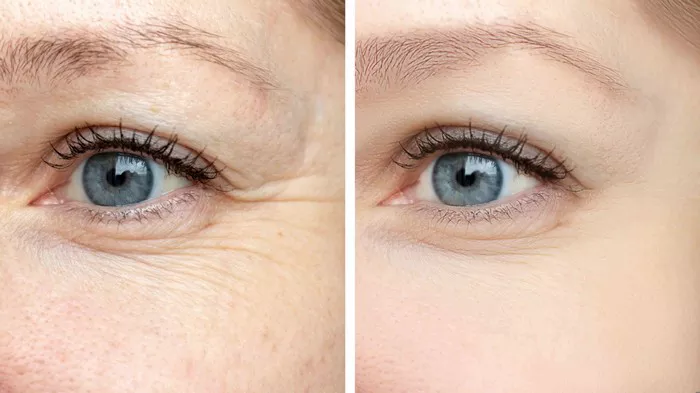The delicate skin around the eyes is particularly susceptible to the effects of aging, stress, and environmental factors. Lines under the eyes, often referred to as under-eye lines, crow’s feet, or fine lines, are a common concern for many individuals seeking youthful and vibrant skin. Understanding the underlying causes of these lines can empower you to take proactive steps in preventing and minimizing their appearance. In this article, we will delve into the various factors that contribute to the development of lines under the eyes and explore strategies to address this concern.
Natural Aging Process
As we age, the skin undergoes a series of changes that can lead to the formation of lines under the eyes. These changes include:
Loss of Collagen and Elasticity: Collagen and elastin are proteins responsible for maintaining skin’s firmness and elasticity. Over time, the body’s natural production of these proteins decreases, resulting in skin that is more prone to sagging and the development of fine lines.
Thinning of the Skin: The skin around the eyes is thinner than the skin on the rest of the face. As we age, the thinning of this skin can make blood vessels more visible, contributing to the appearance of dark circles and fine lines.
Decreased Hydration: Aging can lead to a reduction in the skin’s ability to retain moisture, resulting in dryness and the formation of fine lines. The under-eye area is particularly susceptible to dehydration due to its thinness.
Slower Cell Turnover: The skin’s natural process of shedding old skin cells and generating new ones slows down with age. This can lead to a dull and lackluster complexion, as well as the accentuation of fine lines.
Sun Exposure and UV Damage
Excessive sun exposure is a significant contributor to the development of lines under the eyes. Ultraviolet (UV) radiation from the sun breaks down collagen and elastin fibers in the skin, accelerating the aging process. Prolonged and unprotected sun exposure can lead to the premature appearance of fine lines, wrinkles, and other signs of aging. Protecting your skin from UV radiation by using sunscreen, wearing protective clothing, and avoiding peak sun hours can help prevent further damage.
Repetitive Facial Expressions
The muscles responsible for facial expressions can also contribute to the formation of lines under the eyes. Repeated facial movements, such as squinting, smiling, and frowning, can lead to the development of dynamic wrinkles, also known as expression lines. Over time, these dynamic wrinkles can become more prominent, even when the face is at rest.
Sleeping Positions
Believe it or not, your sleeping position can also play a role in the development of lines under the eyes. Sleeping on your side or stomach with your face pressed into the pillow can cause friction and pressure on the delicate skin around the eyes. Over time, this can lead to the formation of sleep lines and creases. To minimize this, consider sleeping on your back and using a silk or satin pillowcase to reduce friction.
Smoking and Lifestyle Factors
Unhealthy lifestyle habits, such as smoking and excessive alcohol consumption, can accelerate the aging process and contribute to the development of lines under the eyes. Smoking narrows blood vessels and reduces blood flow to the skin, resulting in a decrease in collagen production and elasticity. Additionally, poor nutrition and lack of hydration can impact skin health and make lines more noticeable.
Genetics
Genetics also play a role in determining an individual’s predisposition to developing lines under the eyes. If your parents or grandparents have a history of premature aging, you may be more prone to experiencing similar skin concerns.
Prevention and Management Strategies
While lines under the eyes are a natural part of the aging process, several strategies can help prevent their formation and minimize their appearance:
Sun Protection: Regularly applying broad-spectrum sunscreen with at least SPF 30 can shield the skin from UV damage and prevent premature aging.
Hydration: Keep the skin well-hydrated by drinking ample water and using moisturizers specifically formulated for the delicate under-eye area.
Healthy Lifestyle: Avoid smoking, limit alcohol consumption, and maintain a balanced diet rich in antioxidants, vitamins, and minerals to support overall skin health.
Gentle Skincare: Use gentle skincare products and avoid harsh ingredients that can strip the skin of moisture and exacerbate the appearance of lines.
Eye Creams: Incorporate eye creams containing ingredients such as hyaluronic acid, peptides, retinol, and antioxidants to target specific concerns like hydration and collagen production.
Facial Exercises: Engaging in facial exercises can help strengthen facial muscles and minimize the appearance of expression lines.
Sleeping Habits: Adopting a back-sleeping position and using a silk or satin pillowcase can reduce the likelihood of sleep lines.
Professional Treatments: Consult a dermatologist or skincare professional for treatments such as dermal fillers, chemical peels, or laser therapies that can effectively address under-eye lines.
Conclusion
Lines under the eyes are a natural consequence of aging and various environmental factors. By understanding the causes of these lines, individuals can take proactive steps to prevent their formation and minimize their appearance. Adopting a holistic approach that includes sun protection, a healthy lifestyle, proper skincare, and potential professional treatments can contribute to maintaining smoother and more youthful-looking skin around the eyes. Remember that embracing the aging process and practicing self-care are key to feeling confident and comfortable in your own skin.


